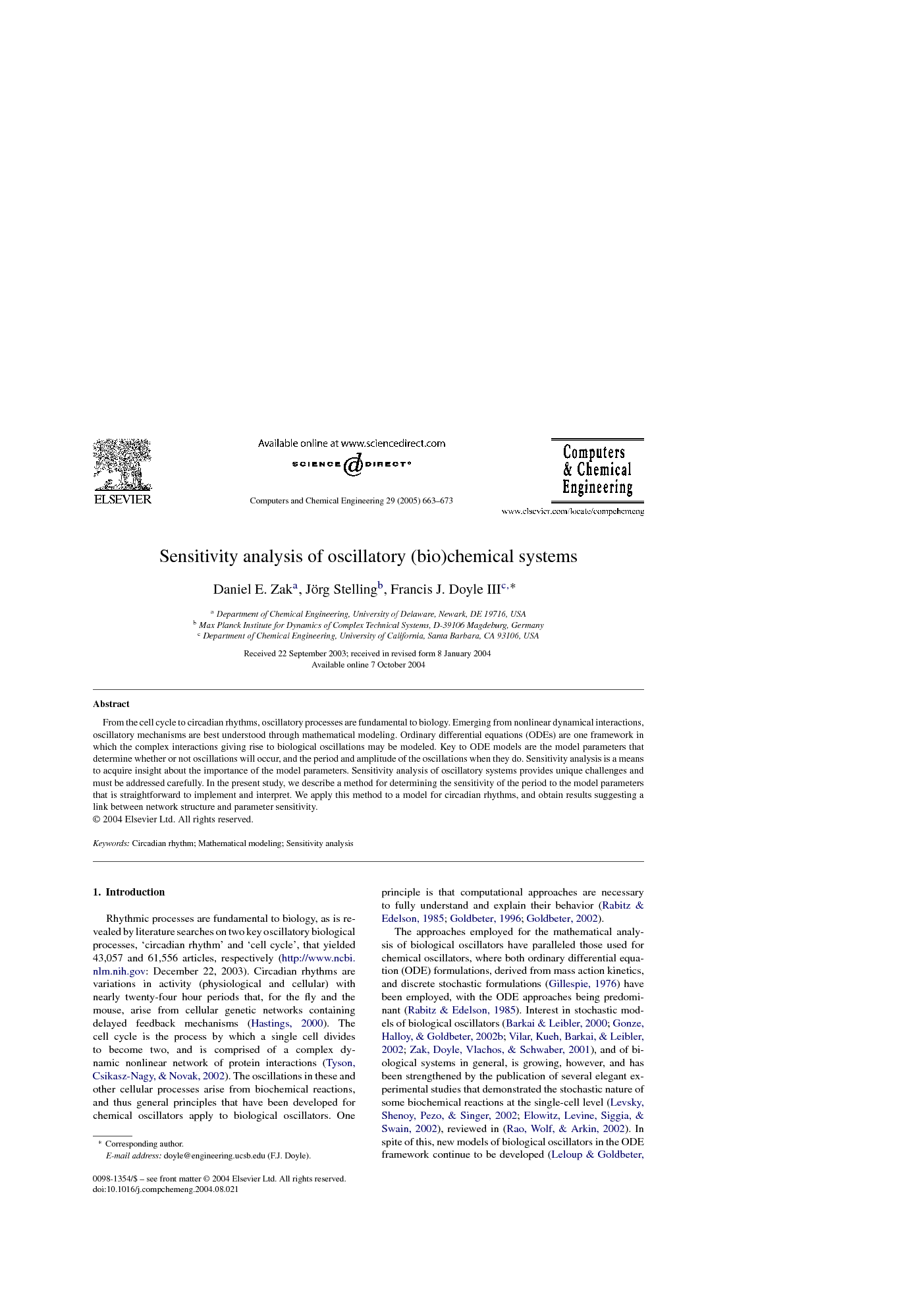تجزیه و تحلیل حساسیت نوسانی (زیستی) سیستم های شیمیایی
| کد مقاله | سال انتشار | تعداد صفحات مقاله انگلیسی |
|---|---|---|
| 25778 | 2005 | 11 صفحه PDF |

Publisher : Elsevier - Science Direct (الزویر - ساینس دایرکت)
Journal : Computers & Chemical Engineering, Volume 29, Issue 3, 15 February 2005, Pages 663–673
چکیده انگلیسی
From the cell cycle to circadian rhythms, oscillatory processes are fundamental to biology. Emerging from nonlinear dynamical interactions, oscillatory mechanisms are best understood through mathematical modeling. Ordinary differential equations (ODEs) are one framework in which the complex interactions giving rise to biological oscillations may be modeled. Key to ODE models are the model parameters that determine whether or not oscillations will occur, and the period and amplitude of the oscillations when they do. Sensitivity analysis is a means to acquire insight about the importance of the model parameters. Sensitivity analysis of oscillatory systems provides unique challenges and must be addressed carefully. In the present study, we describe a method for determining the sensitivity of the period to the model parameters that is straightforward to implement and interpret. We apply this method to a model for circadian rhythms, and obtain results suggesting a link between network structure and parameter sensitivity.
مقدمه انگلیسی
Rhythmic processes are fundamental to biology, as is revealed by literature searches on two key oscillatory biological processes, ‘circadian rhythm’ and ‘cell cycle’, that yielded 43,057 and 61,556 articles, respectively (http://www.ncbi.nlm.nih.gov: December 22, 2003). Circadian rhythms are variations in activity (physiological and cellular) with nearly twenty-four hour periods that, for the fly and the mouse, arise from cellular genetic networks containing delayed feedback mechanisms (Hastings, 2000). The cell cycle is the process by which a single cell divides to become two, and is comprised of a complex dynamic nonlinear network of protein interactions (Tyson, Csikasz-Nagy, & Novak, 2002). The oscillations in these and other cellular processes arise from biochemical reactions, and thus general principles that have been developed for chemical oscillators apply to biological oscillators. One principle is that computational approaches are necessary to fully understand and explain their behavior (Rabitz & Edelson, 1985; Goldbeter, 1996; Goldbeter, 2002). The approaches employed for the mathematical analysis of biological oscillators have paralleled those used for chemical oscillators, where both ordinary differential equation (ODE) formulations, derived from mass action kinetics, and discrete stochastic formulations (Gillespie, 1976) have been employed, with the ODE approaches being predominant (Rabitz & Edelson, 1985). Interest in stochastic models of biological oscillators (Barkai & Leibler, 2000; Gonze, Halloy, & Goldbeter, 2002b; Vilar, Kueh, Barkai, & Leibler, 2002; Zak, Doyle, Vlachos, & Schwaber, 2001), and of biological systems in general, is growing, however, and has been strengthened by the publication of several elegant experimental studies that demonstrated the stochastic nature of some biochemical reactions at the single-cell level (Levsky, Shenoy, Pezo, & Singer, 2002; Elowitz, Levine, Siggia, & Swain, 2002), reviewed in (Rao, Wolf, & Arkin, 2002). In spite of this, new models of biological oscillators in the ODE framework continue to be developed (Leloup & Goldbeter, 2003; Forger & Peskin, 2003), and stochastic and deterministic simulations are often used as complementary, rather than competing, methods by individual groups (Gonze, Halloy, & Goldbeter, 2002a; Gonze, Halloy, Leloup, & Goldbeter, 2003; Leloup & Goldbeter, 1999; Novak, Pataki, Ciliberto, & Tyson, 2001; Sveiczer, Tyson, & Novak, 2001; Vilar et al., 2002). Generally, the ODE framework is used because of its ease of simulation and analysis with available software tools (Maly & Petzold, 1996; Shampine & Reichelt, 1997), while the stochastic framework is used to explore fluctuations. Interestingly, there have been a number of studies of biological oscillators where predictions made using the ODE framework have held up in a stochastic framework, with the effect of stochastic noise largely being the widening of the limit cycle (Gonze, Halloy, & Goldbeter, 2002a; Gonze et al., 2003). Thus, while experimental results have demonstrated that the stochastic nature of some biological reactions cannot be neglected, ODEs, and tools to analyze them, are likely to continue to be of importance to the computational biology community. Given that oscillating chemical systems typically consist of larger numbers of molecules and potentially faster reactions, we also expect ODEs to continue to play an important role in the study of chemical oscillators. ODE models of biological processes often involve many parameters, and the importance of these parameters in determining system behavior must be assessed in order to gain mechanistic insight and to design informative experiments. Sensitivity analysis is one technique to investigate the importance of parameters. Sensitivity analysis has been applied in a few cases to the analysis of biological systems, with the objectives of mechanism discrimination on the basis of model sensitivity (Morohashi et al., 2002; Savageau, 1971), experimental design and parameter estimation (Leif & Jorgensen, 2001; Schlosser, 1994), and the relationship between sensitivity and identifiability (Stelling & Gilles, 2001). In the present work, we consider the parametric sensitivity analysis of ODE models of biological oscillators, where the parameters determine both the existence of and characteristics of the oscillations. Since the period of biological oscillators is a key aspect of their physiological significance (for example, the time-keeping nature of circadian rhythms), we specifically consider the parametric sensitivity of the period. Direct application of sensitivity analysis to oscillating systems gives rise to secular terms (Larter, 1983), and thus must be done with care. In the present work, we first discuss the standard methods for the sensitivity analysis of oscillatory systems, and then present a novel method based on singular value decomposition (SVD) that is easier to interpret and implement than the common methods. We conclude with a case study of an ODE model for circadian rhythms.

